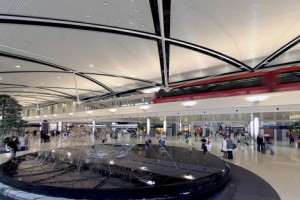
The tram wizzes by at Detroit's airport. Photo from DTW.
Recently I was hanging out at Austin-Bergstrom International Airport (AUS) waiting for a flight back home and I became annoyed that their airport did not provide free Wi-Fi internet. Oddly the airport did have free wired terminals were folks could check their email. I have become a spoiled traveler. Seattle-Tacoma International Airport (my home base) has had free internet for quite some time. The more I travel the more and more I start finding free wireless access at airports. Heck, while waiting for the bus in Austin to go to the airport, I got free Wi-Fi from the city of Austin while standing at my bus stop.
I was voicing my frustration about no free Wi-Fi at AUS via Twitter, when Scott Wintner, who works for Pubic Affairs for Detroit Metropolitan Airport (DTW) and Willow Run Airport (YIP), reached out via Twitter and wanted to share why many airports do not offer free Wi-Fi. He pointed out that Wi-Fi isn’t free and not all airports can afford to give it to passengers without charging. I decided to try and learn more about why more airports don’t have free Wi-Fi and Wintner was more than happy to help out. Here is our talk:
AirlineReporter.com (AR): When did DTW get Wi-Fi?
Scott Wintner (SW): December 2003
AR: Who is it through?
SW: Concourse Communications (now part of Boingo)
AR: How much does it cost a passenger to get internet?
SW: The rates are established by the provider (Boingo), which currently offers several different rates and packages. You can find all of their rate/package info online at www.boingo.com (there are many to choose among). It’s important to note that, because we use one of the leading global providers, internet purchased for use at DTW also works at hotspots around the country and, with some plans, the world. Plus, customers who already have a Wi-Fi plan with another carrier with which Boingo currently has roaming agreements (such as AT&T, T-Mobile, etc.), you can login to our Wi-Fi using your existing account.
AR: How much does DTW get from each internet purchase?
SW: That’s a complicated question because it’s not as simple as a flat % or sum per transaction. So, the best I can offer you will likely be an annual total’¦ which our finance folks are working on for me now. Please standby’¦
AR: How much did it cost DTW to set up Wi-Fi?
SW: It didn’t cost the Airport Authority anything because the system was developed by the provider (Boingo). They may be able to provide you with more info about how much a system such as the one in place at DTW costs to set-up and maintain.
AR: Does “free” Wi-Fi even exist?
SW: There is ’œno such thing as free Wi-Fi’. A wireless internet infrastructure costs money to develop and maintain’¦ no news there. So, that cost has to be paid by someone. When you stay at a hotel that offers free Wi-Fi, you can bet that the cost of providing the service is merely baked-in to their operating costs and reflected in room rates. Likewise, when you go to a coffee shop, etc., that offers ’œfree Wi-Fi’, the cost of providing that service is assumed in the price you pay for a latte or a bagel there. Of course, a for-profit business could elect to absorb the cost of providing Wi-Fi by paying for it out of profits rather than charging more for their goods/services. I don’t think it’s likely for many businesses to choose that option. But, either way, someone is paying for the cost of providing internet ’“ and generally, it’s the customer.
AR: How do airports differ?
SW: Unlike hotels (which charge for a bed) and coffee shops (which charge for caffeine), airports do not charge their customers to use the airport. Yes, airports do charge for ancillary services such as parking and food/beverage/retail, but those services aren’t the airports primary reason for existing. Airport customers can ’“ and many do ’“ pass through the facility without spending a dime. So, airports can’t just jack-up their nightly rate or their admission fee to cover the costs of providing free Wi-Fi ’“ there are no such fees to raise. Sure, airports could jack-up the price of parking and concessions to cover the cost of Wi-Fi ’“ and many probably do.
AR: Can’t the costs be added to the airline’s fee for flying to an airport?
Raising airline costs at airports creates a whole separate set of effects. At minimum, those added airline costs become reflected in ticket prices. But, in most cases, added airline costs become a huge disincentive for airlines to expand (and in some cases even maintain) air service at that airport’¦ which could lead to fewer options and less competition (read: higher prices). In either case, travelers are ultimately paying the bill.
AR: Why has DTW decided not to provide “free” Wi-Fi?
SW: While finding a way to cover the cost of providing Wi-Fi is one thing, here in Detroit (as at many airports), we take it a step further. Much like parking, food and retail, we approach Wi-Fi as an important revenue stream. It’s not a matter of lining our pocketswe don’t make a profit and haven’t run a surplus in our 100 year history. Meanwhile, we have an incredible airfield here and two beautiful, new terminals that need to be both paid-off and maintained. We get a lot of kudos on our facilities here, and both travelers and airlines appreciate that we rarely have delays to due capacity issues at DTW. But, maintaining J.D. Power & Associates #1 Airport in customer satisfaction takes money. We have to get it from somewhere’¦ and, for the reasons I described above’¦ it’s incumbent upon us ’“ for the good of the community ’“ to generate as much revenue from non-airline rent sources as possible.
AR: How much does Wi-Fi factor into the airport making money?
SW: Wi-Fi is a tiny percentage of our overall revenue, but it’s something ’“ and, it at minimum pays for itself. We hope it can pay us even more, because our customers enjoy the things such revenue is used to pay for (i.e., heat, hot water, clean bathrooms, working escalators, a tram that whisks connecting customers through the mile-long Concourse A in 2 min to make their connection, clear runways, top-notch safety and security systems, etc.)
AR: Why do any airports provide “free” Wi-Fi then?
SW: To that question, I refer you back to my first key point ’“ it’s not really free. How do some airports justify increasing costs elsewhere to cover providing free Wi-Fi? That you’d have to ask other airports. But, for smaller airports, it’s often for competitive reasons. Lots of people say to me, ’œI can’t believe you don’t have free Wi-Fi’¦ even the tiny LANSING airport has free Wi-Fi,’ ’“ as if to suggest that a smaller airport would be the last to offer such a service. In reality, those smaller airports need to find ways to incentivize travelers to use them (and I say ’œsmall’ loosely ’“ airports such as OAK are actually not that small, but they are the ’œlittle guy’ competing aggressively for Bay Area traffic). In their case, airlines aren’t likely to serve their airport unless the airport can show that travelers demand such air service. The economics of the smaller ’œspoke’ airports are just entirely different than hub airports.
AR: Is there anything else travelers should know about DTW?
SW: Despite being a major hub for Delta (their second-largest), and formerly the largest for Northwest, DTW has an impressive roster of other carriers. Since we became an independent Airport Authority in 2002 (which largely affected our economics in terms of a focus on lowering airline costs), we’ve added service by Frontier, AirTran & Air France’¦ and have gained new service on Southwest, Spirit & US Airways. All of those carriers fly routes also and already flown by NW/DL, which means we’ve been able to keep the economics to these carriers good enough to take-on an established hub carrier in their own hub and not only be successful, but GROW. That’s not easy to do ’“ look at CLE today, MSP (until very recently), EWR, etc. We’ve done it with our focus on low-cost operations. We’re not the Nordstrom of airports’¦ we’re more like the Target of airports. People fly out of DTW because they know they’ll get great rates and good service with LOTS of options all under one roof.
Hmm, okay I guess I have to be forgiving of this. How can I say it is alright for airlines to charge fees on things, since I shouldn’t have to pay for what I do not use, when I demand “free” Wi-Fi at the airport. It might be a bit selfish of me to ask others to help pick up with bill for Wi-Fi when not everyone will be using it. Just it can be difficult to pay out $10 for airport Wi-Fi, then another $10 for Wi-Fi on the plane. Of course, no one is forcing me to pay for it.
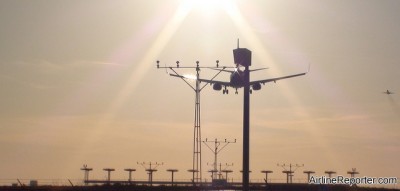
AirTran Boeing 737 landing in Atlanta.
As I am sure you know, Southwest is try to purchase AirTran. This is a very interesting process since we are looking at two low cost carriers becoming one and Southwest taking on a new aircraft type: the Boeing 717.
There are still a lot of questions out there about the merger and I was hoping to get some more insight while hanging out with Southwest in Dallas for their yearly media day. Unfortunately at this point there aren’t a heck of a lot more answers, but I at least have a few more pieces of information.
The big thing to remember is that Southwest and AirTran are still separate companies and competitors. Even though it looks like this buy-out should go through with no issue, AirTran is not about to give up all their secrets until the deal is final. This doesn’t mean that Southwest isn’t working hard already, they just don’t have all the answers right now. Southwest currently has 30 different teams in seven different categories to prepare for the new larger company.
The addition of the Boeing 717 to Southwest’s all Boeing 737 fleet is something that definitely piques my curiosity. Southwest stated they feel this will be one of the smoothest transitions. AirTran already has a good system with their 717 and 737 aircraft and they plan to keep AirTran’s current system of organizing the different planes.
When asked about the Boeing 717 and Boeing 737-500, which are designed to serve similar markets, Southwest stated that the 737-500’s will be coming off lease in 2013-2015. At that time, they will want to have a newer small aircraft to replace them. They made it sound like the Boeing 717 would do that perfectly, but I am not so sure. I wonder if the Boeing 717 is the right aircraft type to provide smaller markets. It seems it might be beneficial for Southwest to look at not being an “all Boeing” airline and start looking at Bombardier C-series aircraft.
Another big interest is Southwest being able to start flying out of Atlanta (ATL). They seem very excited to get AirTran’s slots and are already planning to serve at least 24 new destinations from ATL that AirTran doesn’t currently serve. Southwest stated they aren’t looking to directly complete with any airlines in ATL (aka Delta), but am guessing there is more talk of competition behind closed doors. Southwest explained they hope they could offer airfares as much as 40% lower to ATL than the competition (aka Delta). Now that sounds like competitive talk to me. It looks like ATL will become quite important to Southwest. They stated that Atlanta might quickly become the largest city in their network, flying up to 2,000,000 passengers to the airport.
Some media voiced their concern about loyal AirTran passengers who are used to Business Class, Wi-Fi on all their flights and assigned seats. This is a big change to transition to all economy, Wi-Fi on some aircraft (will be all by mid-2013) and open seating. Southwest didn’t seem too concerned. They stated they know there are quite a few loyal Southwest passengers who would love to fly them into ATL, but just can’t do it right now. They also plan to educate fliers to promote Southwest’s unique brand of service.
Southwest stated that they aren’t looking to eliminate AirTran with the buy out, but that they hope to learn from them in every way they can to make a bigger and better airline. With Southwest announcing they will be flying into larger airports like Newark on top of buying out AirTran, it is anyone’s guess what Southwest might do next. There was talk of flying longer distances possibly Hawaii (which was mentioned half a dozen times), South America and more. I say… game on.
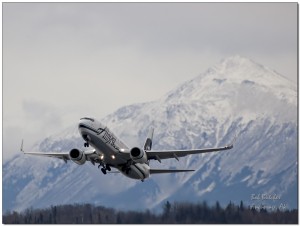
Alaska Airlines Boeing 737-800 taking off from Anchorage, AK.
Airlines adding wi-fi to their fleet is nothing new. But Alaska Airlines announcing they will be adding GoGo Inflight for their Wi-Fi service is exciting since: #1 They were testing Row44 and decided to go with GoGo instead and #2 Alaska is my hometown airline (based in Seattle), I fly them often, and I love having the internet at 30,000 feet.
Alaska has been testing Row44’s satellite-based internet service for quite sometime now. Row44’s main customer is Southwest Airlines. Many thought Alaska would go with Row44 since they have flights to Hawaii and remote areas of Alaska where cell towers, needed by GoGo, do not exist.
Why is Alaska willing to forgo service on all their routes to go with GoGo? A few reasons. First GoGo equipment costs less and takes less time to install on aircraft. This would mean a lower investment at the beginning and not as much lost revenue due to aircraft not being able to fly during installation. Also GoGo is installed on many different airlines all over the US already and has proven itself as a viable service.
GoGo, attempting to get Alaska’s business, has agreed to expand its network into Alaska, however flights to Hawaii will still have no internet (but heck those passengers are going to Hawaii…nice tropical, warm Hawaii. They can deal with no internet).
To get FAA certification, one Boeing 737-800 will get GoGo installed, then the service will be installed fleet-wide.
Mary Kirby, with Flight Global’s Runway Girl, also has another opinion on this choice. She asks if Southwest and Row44 might have some arrangement in the works, which would have either delayed installation of Row44 into Alaska’s aircraft or Southwest might invest in Row44 and partly own the company. Only time will tell!
connect | web | twitter | facebook |
Image: Bob Butcher
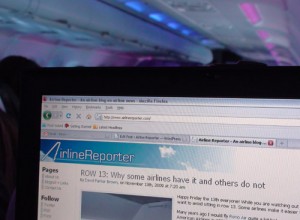
I only read the best stuff while on my flights. Taken just a few minutes ago.
I am currently posting this from 36,239 feet on a Virgin America flight from San Francisco (SFO) to Seattle (SEA). The in-seat map tells me we are over Central Oregon. Today I flew to San Fran and I’m now flying right back to Seattle to test out Virgin America’s in-flight entertainment system. I will post a full review of my experience on Monday, but while enjoying the Wi-Fi, I wanted to talk about it a little bit.
I am currently accessing the internet via GoGo and I don’t have to pay a dime. Virgin America, with Google, is offering free Wi-Fi on all their flights from now until January 15, 2010. Delta Air Lines, with eBay, is providing free Wi-Fi for a week starting November 24th.
The free internet is not only for folks on an airplane. Until January 15, 2010 Google will provide complimentary Wi-Fi in 47 airports across the country, including Las Vegas, Boston, Houston, Miami, and Seattle.
Seattle was supposed to be one of the 47 airports with free Wi-Fi. However, when I was there earlier today, I was excited to do some blogging while waiting for my flight to leave but it wasn’t free. Luckily I have an iPhone (airline and tech nerd) and found that there is a contract issue between AT&T (the current provider) and the airport.
Other airports got the Wi-Fi this Tuesday, but Seattle won’t be seeing it until November 18th. Every cloud has its silver lining; Seattle and Burbank airports will have free Wi-fi forever. I guess I will be ok with no Wi-Fi today for perpetually free Wi-Fi in a few days.
I am no stranger to technology and I fly quite a bit, but every time I have the access to the internet while flying, it feels magical. Some people say the magic of flying is gone but I disagree, it just depends on who you fly.
Internet is the future of airline travel. I feel that all airlines will have internet access in the near future. Once an airline cuts the Wi-Fi for landing, it is only a few minutes to re-connect on the 3G network and be connected once again. Awhile back, I talked about the possibility of having free Wi-Fi on airlines, but Andrew Compart with Things with Wings came up with another possible change that Wi-Fi could cause.
He caught something interesting in the Google media release about the free Wi-Fi, “A recent study conducted by the Wi-Fi Alliance reported that 50% of business travelers take red-eye flights in order to be “reachable” during business hours, and an overwhelming 82% said that being connected through Wi-Fi would help solve that problem.”
He brings up a good question that with business travelers having access to Wi-Fi during their flights, will fewer take red eye flights? Will that affect an airline’s business flying at night? I hope not. For personal travel, I enjoy red-eyes since I am able to sleep and I want as much vacation time as possible.
A year ago, there was barely any Wi-Fi on any flights. Hopefully a year from now Wi-Fi will be so common that there’s nothing left to even write about.. I think I am going to wrap up now, time to play Doom for the rest of the flight back home!
follow via | web | twitter | email | rss |
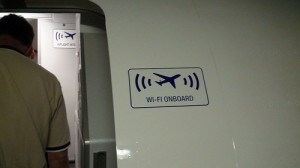
The sign outside of my first Wi-Fi flight back in May.
Yes! I am coming out and predicting that someday Wi-Fi will be free on at least some airlines. I am not talking first class or business class; I am talking about free Wi-Fi for the entire plane. Let me explain…
Southwest Airlines is the newest airline to announce adding Wi-Fi to their flights. Many other airlines already have some or all of their fleets wireless. It took the industry a long time to start becoming wireless, but now almost all US airlines have at least a few Wi-Fi equipped aircraft. The rapid growth shows capitalism at its best. When one airline has Wi-Fi, it provides an obvious advantage over those that do not. However, when almost all airlines in the United States have Wi-Fi, where does one airline stand out over another?
Think about long-distance on landlines (you remember those, right; where wires connected your phone calls?). It used to be mighty expensive to call based on time of day, then there were flat rates per minute, then you could just pay a monthly fee and call whenever and whomever you wanted. The same phenomenon happened with cell phones. Minutes used to be costly, now companies have plans with unlimited minutes, rollover minutes, etc. As competition grows, so do the benefits for the customer.
With Wi-Fi on the airlines, it is a bit more complicated; airlines don’t run the Wi-Fi, independent companies do. Some airlines like American, Delta, and AirTran are using Aircell’s GoGo tower-based Wi-Fi service, but Southwest is using Row44, which is a satellite-based system. Either way, Wi-Fi companies are competitive businesses that have to charge the airlines, so the airlines would need to absorb the costs to provide free Wi-Fi.
I know, with airlines charging fees for everything today, why would an airline ever be willing to absorb the costs? I think we are in a unique time. I don’t expect all these fees to be around forever (at least I hope not). All it would take is one airline. One airline to announce they have free Wi-Fi. It might be years from now when this happens, and it might take a few more years for other airlines to follow. However, this is how things have become cheaper and free in the past. With so many airlines in the US, it is feasible that one might want to come across as a “high-tech”, “medium frills” airline.
Hopefully I am right in this one, but if I am not, I am still willing to pay $13 to access the internet on a flight!




